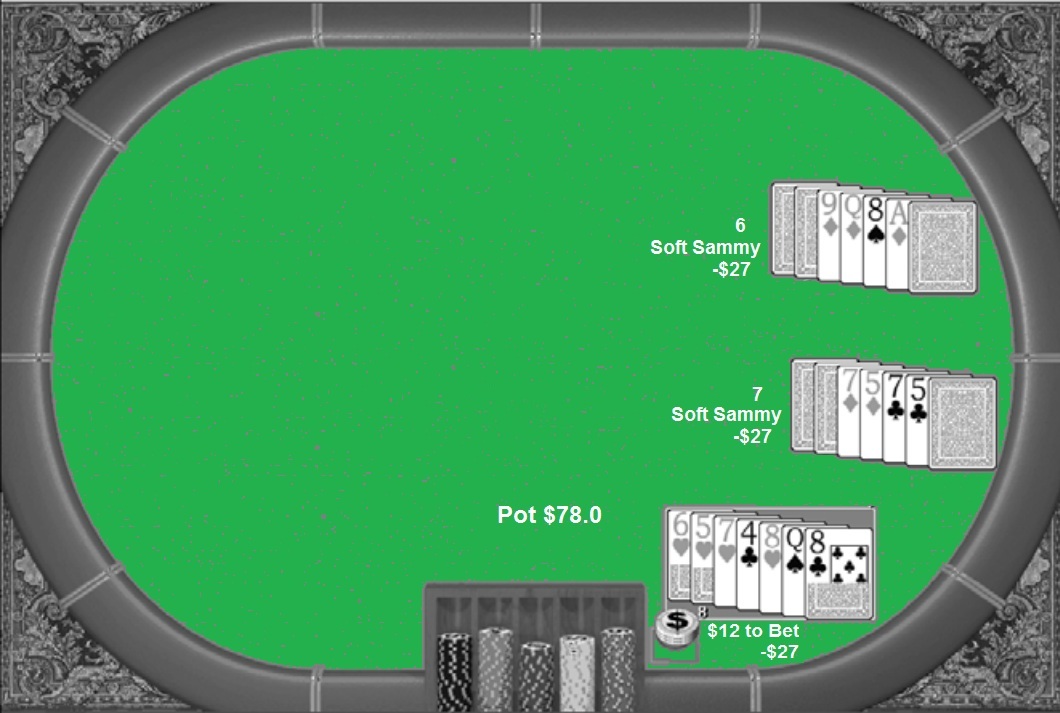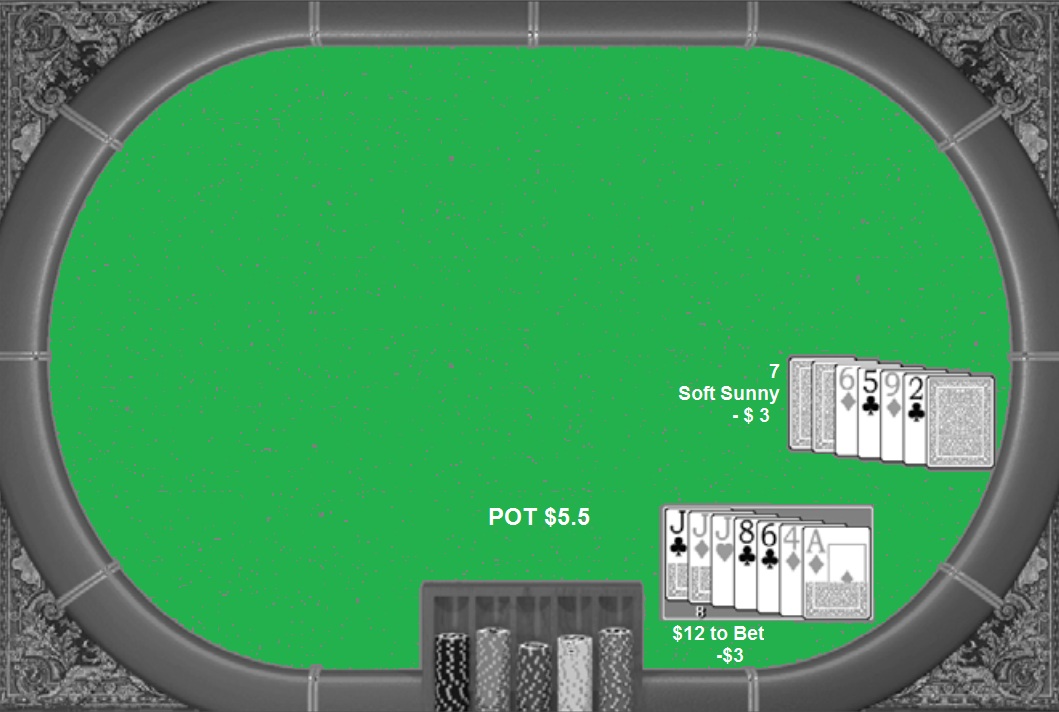Unlike the river card in a flop game, you don’t gain any new information when the last card comes out in a Stud game. You can, however, use the probability, pot odd calculations, and your opponents’ poker patterns to help you determine their likely hands. This section walks you through the hands you can have and offers advice on how to play in each situation.
Playing When You Have a Poker Full House or Higher
Full houses just win, baby. We put the worst full house possible (Twos full of Threes) through a 100,000-hand simulation in Turbo 7 Stud and came out the winner 87 percent of the time, when everyone stayed to the river. Tens full of Deuces, on the other hand, won a whopping 93 percent of the time. When none of your opponents have a pair on board and don’t appear to be threatening a straight flush, you can turn your attention to moving as many chips as possible from their stacks to yours.
You should bet your hand for value in most low-limit games. If you made your full house on the river, you can take a shot at the pot and make your opponents think you only have trips, particularly when you only have a pair showing on board and you hesitate a few seconds before you bet. You hesitate to make your opponents think you’re deciding whether or not to bet your set. If your opponents suspect you just have trips, they are more likely to raise if they have a higher set, a straight, or a flush. If they can’t beat trips, they probably won’t call anyway.
If one or more of your opponents have a pair showing, you have to be a little concerned over whether they might have a full house or not. If someone has trips showing on the board, their set had better be smaller than yours, or you’re in trouble. Sure, you’ll call any bets on the river, but nothing slows you down like TTT on another player’s board when you have 99988.
If you have quads, bet and raise until they make you stop. Quad Deuces with the 3♥3♠3♣ as kickers (we used all Threes to allow the rest of the ranks to form quads) won 98.7 percent of hands when everyone stayed to the river. Unless you see trips or quads on someone else’s board, and their visible set is higher than yours, just keep going. You’ll lose about one hand in a hundred, but that likelihood isn’t significant enough to worry about. If you’re playing at a table where you can win a bad beat jackpot, be thankful your quads came up second best!
Playing When You Have a Poker Straight or Flush
You should be very happy when you have a straight or, even better, a flush in seven-card Stud, but even an Ace-high flush with a weak second card is vulnerable to a higher flush or a full house. Straights are even more vulnerable. To play a straight or a flush well, you must examine your opponents’ boards and determine whether they stuck around trying to improve their two pair or trips, or whether they believed they have the straight or flush you’re representing beat. As an example, consider the hands in this figure:

Your opponents checked and called on fifth and sixth streets, but you should suspect you’re up against a full house when the player showing the pair bets on the river, and only one or two of the cards they would need to make the full house are gone. Your board more or less gives away the fact that you have a straight and not a flush; you have just two cards of the same suit showing, the suited cards were the last two cards to appear on your board, and your upcards contain three cards to the straight. The other opponent called the bet as well, but you might not be as worried about that hand. If the player at the bottom right of the table has a straight, it can’t beat yours. It’s possible the player at the bottom right has a flush, but it would had to have come on the last card.
It’s worth your while to call in this situation, for a couple of reasons. First, you can call because an observant and aggressive opponent will likely bet trips against a board showing three to a straight, particularly when two of the straight cards are two ranks apart, like the Nine and the Queen in this example. You would need to have exactly a Ten and Jack in the hole to make the straight, which you do, but that’s the sort of uncertainty that can convince an aggressive player to take a chance on betting their set.
Playing flushes is easier because your hand is so much stronger, but you must consider whether your high cards beat other potential flushes. The figure below shows a typical situation where your flush is in some danger.
Both you and your opponent show three cards to the fl ush, but your opponent shows A♥T♥, and your second highest fl ush card is the 9s. You should still play the hand to the end, but you might consider not betting, unless you’ve seen three of your opponent’s fl ush cards go into the muck. The aggressive play is to bet and call any raise, of course, but let your experience and knowledge of your opponent be your guide.
Playing When You Have Trips or Two Pair
We’re not exaggerating when we say that you will win and lose more money at seven-card Stud with two pair than you will with any other hand. The next figure shows a typical scenario.

Your Kings and Tens don’t look very strong in this situation, but there’s still hope. If your opponent bet after the Ace hit, you may very well be up against Aces and Nines. On the other hand, if your opponent checked and called after the Ace hit, two pairs smaller than Aces seems more likely. When you’re in this type of situation, think back through the hand and glean what you can from the betting pattern. Raising the bring-in signals a big pair, or at least a pair bigger than any remaining upcards. In that case, you might be up against Queens and Nines instead of Aces and Nines. Our advice? Call, unless your opponent’s visible pair outranks your larger pair.
You’re in much better shape when you have trips, but you’re still not out of the woods. Straights just seem to pop up when you have three of a kind. As an example of what can go wrong, check out the hand in this figure:

In this hand, your opponent made the bring-in bet, and three players called but did not raise. The last bit is important: Because no one put any pressure on the bring-in, there could be any three cards underneath. If your opponent raised on sixth street, you’re probably going against a straight. You should call opponents who you know tend to poker bluff with scary boards, but if you’re sure you’re beat, go ahead and save your money for another hand. However, if you don’t see a likely straight or higher pair on another player’s board, go ahead and bet your set on the river.
Playing When You Have One Pair or Worse
One pair rarely wins in seven-card Stud, but it can happen. If no one has been driving the betting, and you don’t see a higher pair on anyone’s board, check and call on the river. You may be up against a small two pair, but your bigger pair may still take down the pot. Of course, if you miss your straight or flush draw entirely, and don’t think you can drive your opponent out of the pot with a bet, check and fold.










